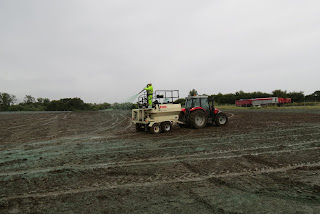The filth and the flora - from sewage sludge to wildflowers
They were once a series of foul-smelling sewage lagoons - but soon they will be blossoming into life.
These lagoons at Ballynacor outside Craigavon were used for nearly 50 years to store sewage sludge, but are being transformed into glorious wildflower meadows.
Next year, yellow rattle, ragged robin and ox eye daisy will be blooming all over what was once an eyesore.
The development of a wildflower meadow on the seven hectare restoration site owned by NI Water, next to the fully operational Ballynacor Wastewater Treatment Works in Derrymacash, is being led by Ulster Wildlife in partnership with EcoSeeds, and Armagh, Banbridge and Craigavon Borough Council, and is the first project of its kind in Northern Ireland.
The five lagoons cover an area of almost 7 hectares and are up to 5m deep in places. They were originally used for long term storage of the solids by-products generated by wastewater treatment in the Craigavon area.
When the upgrade of the wastewater treatment works at Seagoe, Bullays Hill and Ballynacor were completed in 2009 under a Public Private Partnerships contract between NI Water and its PPP contractor Glen Water Ltd, the lagoons were no longer needed as part of the wastewater treatment processes, as all new sludges are transferred to Belfast for incineration.
As part of the PPP contract, Glen Water were asked to follow on and remediate the redundant sludge lagoons, restoring them to natural grassland.
Ulster Wildlife recently began planting the in-filled lagoons, using more than 300kg of native wildflower seeds harvested from local meadows in Oxford Island Nature Reserve and Fermanagh.
A large hydro seeder was used to spray the ground with a mixture of water, seeds and soil tackifer to soften and stabilise the seed bed.
No corner of the site has been left untouched and next year, the site will see its first shoots of colourful wildflowers including yellow rattle, ragged robin, meadowsweet and ox eye daisy which will attract pollinating insects, wild birds and small mammals.
Conor McKinney, Living Landscapes Manager with Ulster Wildlife said: “We are thrilled to be leading on this exciting and unique project. Creating a wildflower meadow on former sewage sludge lagoons is as hard as it gets and has never been done before in Northern Ireland.
“By working closely with leading experts, conducting trials, and establishing the right conditions on site, we’re confident it will be a success. Given the huge wildlife benefits and cost savings from axing mowing regimes, we hope to see work starting on other similar sites in the not too distant future.”
The coordination of the wildflower landscaping project on behalf of NI Water was managed by Roisin McDade, scientist and SCAMP Officer.
Roisin said: “This project has been a very worthwhile exercise, greatly improving the lagoons by transforming them into a wildlife haven for many years to come. This demonstrates what can be achieved when different organisations work together in partnership to improve our local environment.
“On behalf of NI Water, I would like to thank all our partners who helped to make this project happen.”
This project is part of a UK-wide initiative coordinated by The Wildlife Trusts and Plantlife to establish species-rich grassland in every county across the UK.




Comments
Post a Comment